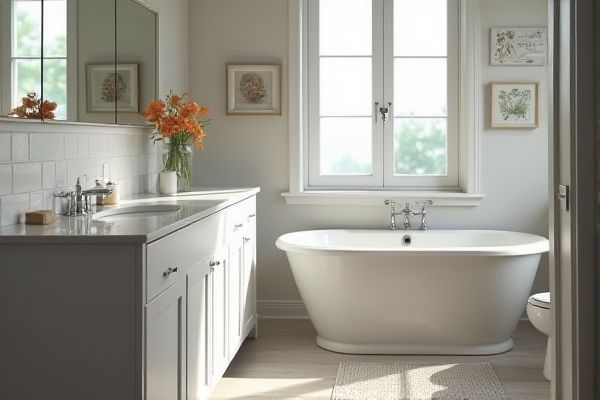
Utility sinks offer deeper basins and more robust materials designed for heavy-duty cleaning tasks, whereas bathroom sinks prioritize aesthetics and compactness for daily personal hygiene. Discover which sink best suits your space and needs by exploring the full comparison in the article ahead.
Table of Comparison
| Feature | Utility Sink | Bathroom Sink |
|---|---|---|
| Primary Use | Heavy-duty cleaning, laundry, utility tasks | Hand washing, personal hygiene |
| Size | Larger, deeper basin | Smaller, shallow basin |
| Material | Durable materials (stainless steel, plastic, cast iron) | Ceramic, porcelain, glass |
| Installation Location | Basements, garages, laundry rooms | Bathrooms |
| Faucet Type | High-arc, often with sprayer | Standard faucet, often with single or double handles |
| Drain Size | Larger drain for debris and water flow | Standard drain size |
| Cost | Generally less expensive, functional design | Varies; often higher due to style and finish |
Introduction to Utility Sinks and Bathroom Sinks
Utility sinks are designed for heavy-duty cleaning tasks, featuring deep basins and durable materials ideal for laundry rooms and workshops. Bathroom sinks prioritize aesthetics and space-efficiency, often incorporating sleek designs and smaller sizes to fit within limited bathroom areas. Understanding the distinct functions can help you choose the right sink for your specific needs.
Key Design Differences
Utility sinks feature deep basins and durable materials like stainless steel or heavy-duty plastic to handle tough cleaning tasks, whereas bathroom sinks prioritize aesthetics with shallow basins and materials such as porcelain or glass. Utility sinks often include accessories like spray faucets or washboards for enhanced functionality, contrasting with bathroom sinks designed for daily hygiene with simple faucets and integrated countertop designs. The placement and size of utility sinks support large or irregular items, while bathroom sinks are sized and positioned for compact spaces and user comfort.
Functionality and Best Uses
Utility sinks are designed for heavy-duty tasks such as washing large items, cleaning tools, and handling messy chores, making them ideal for laundry rooms, garages, or workshops. Bathroom sinks focus on personal hygiene activities like handwashing and grooming, featuring finishes and designs suited for aesthetic appeal and easy cleaning in residential bathrooms. Choosing between a utility sink and a bathroom sink depends on the primary function required and the environment where the sink will be installed.
Installation Requirements
Utility sinks require more robust installation, including reinforced plumbing and floor support due to their larger size and heavier use, compared to bathroom sinks which typically need standard water supply and drainage connections. Utility sinks often need a higher water flow rate and drainage capacity to handle tasks like washing tools or large items, whereas bathroom sinks are designed for lighter use such as handwashing and face washing. Your choice should consider these installation requirements to ensure proper fitting and functionality in the intended space.
Material and Durability Comparison
Utility sinks are typically made from heavy-duty materials such as stainless steel, cast iron, or durable composite resin, designed to withstand harsh cleaning tasks and exposure to chemicals, while bathroom sinks usually use porcelain, ceramic, or glass for a more elegant appearance but less rugged durability. The robust construction of utility sinks ensures they resist scratches, dents, and stains over extended use, making them ideal for laundry rooms or workshops. Your choice between these sink types should consider the balance between durability needs and aesthetic preferences based on the sink's intended function.
Size and Capacity Considerations
Utility sinks are larger and deeper than bathroom sinks, designed to handle bulky items and heavy-duty cleaning tasks with greater capacity. Bathroom sinks are typically smaller, intended for daily personal hygiene activities, and fit comfortably in limited spaces. Choosing the right sink depends on your space availability and the volume of water or items you need to accommodate regularly.
Maintenance and Cleaning
Utility sinks feature deeper basins and more durable materials like stainless steel or heavy-duty plastic, making them easier to clean and maintain after handling tough grime or chemicals. Bathroom sinks, often made from porcelain or ceramic, require gentler cleaning products to prevent surface damage and frequent wiping to avoid soap scum buildup. Routine maintenance for utility sinks involves scrubbing with stronger detergents and occasional disinfecting, while bathroom sinks benefit from regular rinsing and gentle cleaning solutions to preserve their finish.
Cost Differences
Utility sinks generally cost between $150 and $500, offering durable materials suited for heavy-duty cleaning tasks, while bathroom sinks typically range from $100 to $300, with designs focused on aesthetics and compactness. Installation costs for utility sinks can be higher due to additional plumbing requirements and space considerations compared to standard bathroom sink installations. Maintenance and replacement expenses for utility sinks tend to be lower over time because of their robust construction and utilitarian purpose.
Ideal Environments for Each Sink
Utility sinks are ideal for laundry rooms, garages, or workshops where heavy-duty cleaning, rinsing, and soaking tasks take place. Bathroom sinks are designed for personal hygiene activities and fit perfectly in bathrooms or powder rooms with their compact size and aesthetic appeal. Choosing the right sink for your space ensures functionality tailored to your specific cleaning needs.
Choosing the Right Sink for Your Needs
Utility sinks offer deeper basins and durable materials ideal for heavy-duty tasks like cleaning tools or laundry, making them suitable for garages or laundry rooms. Bathroom sinks prioritize style and compact design, featuring smoother surfaces for daily personal hygiene and quick cleanups. Your choice depends on whether functionality for tough jobs or aesthetic appeal and space-saving design are your primary needs.
 homyna.com
homyna.com